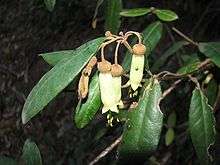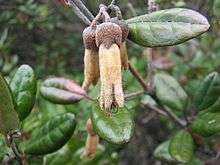Correa lawrenceana
| Mountain correa | |
|---|---|
 | |
| Correa lawrenceana var. latrobeana in Yarra Ranges National Park, Victoria | |
| Scientific classification | |
| Kingdom: | Plantae |
| (unranked): | Angiosperms |
| (unranked): | Eudicots |
| (unranked): | Rosids |
| Order: | Sapindales |
| Family: | Rutaceae |
| Genus: | Correa |
| Species: | C. lawrenceana |
| Binomial name | |
| Correa lawrenceana Hook.[1] | |
| Synonyms | |
| |
Correa lawrenceana, commonly known as mountain correa, is a shrub or small tree of the family Rutaceae that is endemic to Australia.
Description
Correa lawrenceana grows to between 0.6 and 9 metres in height, and has leaves with a shiny, dark-green upper surface which are 2.5 to 10.5 cm in length and about 1 to 7 cm wide. The flowers are produced during the winter and spring and also sporadically throughout the year and are typically yellow-green although other colour forms are known.
Taxonomy
The species was first described in 1834 by English botanist William Jackson Hooker who gave it the name Correa lawrenciana.[1] The specific epithet honours Tasmanian botanist Robert William Lawrence (1807-1833) who, together with Ronald Gunn, collected the plant material sent to Hooker.[2][3] The spelling of the name was standardised to Correa lawrenceana under the International Code of Botanical Nomenclature in 1998.
A subgenus of Correa (Correa subgenus Persistens Othman, Duretto and G.J. Jord.) was formally described in 2011 comprising two species, C. lawrenceana and C. baeuerlenii [4] Unlike other Correa species, C. lawrenciana does not readily form hybrids with other species.[5]
Eight varieties are currently recognised:
- C. lawrenceana var. cordifolia Paul G.Wilson, Pink Mountain-correa. Flowers are pink with yellow tips or, more rarely, entirely yellow.[6] The type specimen was collected from Mount Dromedary in New South Wales in 1953. Other South Coast localities where it occurs include Bermagui, Bodalla and Milton.[3] The variety is listed as "vulnerable" on the Department of Sustainability and Environment's Advisory List of Rare Or Threatened Plants In Victoria.[7]
- C. lawrenceana var. genoensis Paul G.Wilson, Genoa River Correa. This variety is listed as "endangered" under the national Environment Protection and Biodiversity Conservation Act 1999,[8] "endangered" under the New South Wales Threatened Species Conservation Act 1995 [9] and "threatened" in Victoria under the Flora and Fauna Guarantee Act 1988.[10] It occurs on the banks of the Genoa River, including Coopracambra National Park in Victoria, and the adjoining South East Forest National Park in New South Wales.[3][8]
- C. lawrenceana var. glandulifera Paul G.Wilson The type specimen was collected from Springbrook in Queensland in 1929.[1]

- Correa lawrenceana var. grampiana Paul G.Wilson, Grampians Mountain-correa. The type specimen was collected in 1986 from Mount William in Victoria, where it is found growing among rocks.[11] It is listed as "rare" on the Department of Sustainability and Environment's Advisory List of Rare Or Threatened Plants In Victoria.[12]
- C. lawrenciana. var. latrobeana (F.Muell. ex Hannaford) Paul G.Wilson This was originally described as C. latrobeana, based on material collected near the Delatite River in Victoria in 1853.[1] It occurs in south-eastern New South Wales including near Delegate and across the border with Victoria in a south-westerly direction through locations including Buchan, Mount Buffalo, Mount Baw Baw, Warburton and Healesville then extending to the south-west of Melbourne as far as the Otway Ranges.[3]
- C. lawrenceana Hook. var. lawrenceana. Plants in Tasmania are identified as this variety.[13] Those in the north-east of the state have narrow leaves, while those from the south and west have wider leaves with hairy undersides.[14]
- C. lawrenceana var. macrocalyx (Blakely) Paul G.Wilson This was originally described as Correa macrocalyx, based on material collected from Patonga on the Hawkesbury River in New South Wales in 1923.[1] It is also found to the south at Minnamurra.[3]
- C. lawrenceana var. rosea Paul G.Wilson, Red Mountain-correa, a sub-alpine variety with pale red flowers from the Snowy Mountains in southern New South Wales.[3][15] The type specimen was collected near the Geehi River on the Alpine Way in 1958. It is listed as "rare" on the Department of Sustainability and Environment's Advisory List of Rare Or Threatened Plants In Victoria.[6]
Distribution
The species is found in rainforest and sclerophyll forest in Tasmania, Victoria, New South Wales and Queensland.[16]
Ecology
The flowers are presumed to be pollinated by either birds or bees.[8]
Cultivation
Correa lawrenceana is suited to a cool, moist, partly shaded position and is known to tolerate frost and snow. It can be used as a screening plant and will attract honeyeaters to the garden.[17] Plants are easily propagated from cuttings, whereas seed can be difficult.[2]
References
- 1 2 3 4 5 "Correa lawrenceana". Australian Plant Name Index (APNI), IBIS database. Centre for Plant Biodiversity Research, Australian Government, Canberra. Retrieved 26 June 2011.
- 1 2 "Correa lawrenceana". Australian Native Plants Society (Australia). Retrieved 26 June 2011.
- 1 2 3 4 5 6 Wilson, P.G. (1961). "A taxonomic revision of the genus Correa (Rutaceae)." (PDF). Transcriptions of the Royal Society of South Australia. 85: 44–50.
- ↑ Othman, Raja Nur Ateeka; Gregory J. Jordan; James R. P. Worth; Dorothy A. Steane; Marco F. Duretto (2011). "Phylogeny and infrageneric classification of Correa Andrews (Rutaceae) on the basis of nuclear and chloroplast DNA". Plant Sytstematics and Evolution. 288 (3): 127–138. doi:10.1007/s00606-010-0315-0.
- ↑ Duretto, Marco F. "Rutaceae" (PDF). Flora of Tasmania online. Tasmanian Museum and Art Gallery. Retrieved 26 June 2011.
- 1 2 Wild Plants of Victoria (database). Viridans Biological Databases & Department of Sustainability and Environment. 2009.
- ↑ "Advisory List of Rare Or Threatened Plants In Victoria - 2005". Department of Sustainability and Environment (Victoria). Retrieved 25 June 2011.
- 1 2 3 Carter, Oberon; Neville Walsh. "National Recovery Plan for the Genoa River Correa Correa lawrenceana variety genoensis" (PDF). Retrieved 26 June 2011.
- ↑ "Genoa River Correa - profile". Retrieved 3 June 2013.
- ↑ "Flora and Fauna Guarantee Threatened List". Department of Sustainability and Environment. Retrieved 25 June 2011.
- ↑ Corrick, M.G.; Fuhrer, B.A. (2001). Wildflowers of Victoria and adjoining areas. Australia: Bloomings Books. ISBN 1-876473-14-2.
- ↑ "Advisory List of Rare Or Threatened Plants In Victoria - 2005" (PDF). Department of Sustainability and Environment (Victoria). Retrieved 8 April 2012.
- ↑ "A Census of the vascular plants of Tasmania" (PDF). Retrieved 25 June 2011.
- ↑ "Correa lawrenceana (Rutaceae)". Key to Tasmanian vascular plants. University of Tasmania. Retrieved 26 June 2011.
- ↑ Costermans, L. (1981). Native Trees and Shrubs of South-eastern Australia. Australia: Rigby. ISBN 072701403X.
- ↑ "Correa lawrenceana Hook.". PlantNET - New South Wales Flora Online. Royal Botanic Gardens & Domain Trust, Sydney Australia. Retrieved 26 June 2011.
- ↑ Greig, D. (1987). The Australian Gardener's Wildflower Catalogue. Australia: Angus & Robertson. ISBN 0-207-15460-0.
| Wikimedia Commons has media related to Correa lawrenceana. |